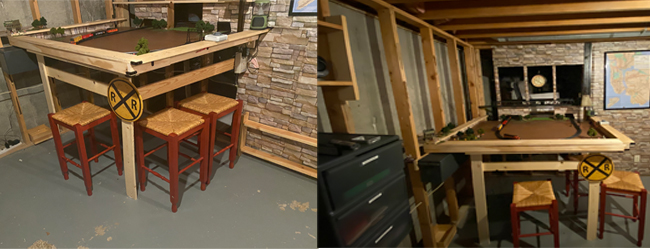In the midst of the COVID pandemic, we were all looking for answers and ways to occupy our time. Many took on new hobbies and projects, all of which helped pass the time, while serving as a way to remain active and have fun. 🙂
For me, I discovered model trains and it came out of an interest to build something from scratch with much room for exploration and innovation. I was cleaning our unfinished basement and one corner of the room stood out as it had all of the essentials: open space, electrical power on both sides of the room and studs for tunnels. Using a ‘floating bar’ design, I broke ground with it in early January, 2021 and it was a good foundation for an oval track. Here are some early shots of it.

What did I learn from it?
Given my limited carpentry skills, I doubted this table would come together from the minute I broke out the tape measure and circular saw, but it actually worked out. Sometimes, it’s good to just dive in and take the plunge. Yes, mistakes will happen, but that is how we learn.
Time to Expand
Once I got over that initial hurdle to build the table, I could see much potential to expand this set, so I started to expand to the other side of the set and built an elevated line. With the right mix of buildings and landscape, it was really taking shape. This video shows both sides of the set in this second phase:
What did I learn? This was an interesting phase of the project as the set started to take shape and I was able to experiment with landscape and lighting, especially interior lighting as well as using a lightbox to create the illusion of moving water and you can see it in the video. To save on costs, I also repurposed everyday materials, like using discarded gutter channels for the elevated lines and cup lids for street corners (thank you QT). : ) During this phase, I also immersed myself in this space with training videos, guides and just talking to fellow train modelers.
Best advice to date: I mentioned to one train modeler that “my set was still a work in progress.” His response summed it up as he told me “it should always be a work in progress. The minute you say it’s done, you might as well sell your set.”
Putting key learnings to work on second set
Innovation comes from testing, learning and keeping ‘your foot on the pedal’ with new layout concepts and seeing what works. I learned a lot from my initial build, including the need for planning and the importance of building in phases. While working on the initial build, I also broke ground with another set that was built on a used ping-pong table. This was also my introduction to Digital Command Control (DCC), the latest in model train technology that offers more robust functionality to control the trains. I called it “Feather Mountain” and it was a different design with more mountains and rural landscape elements. Here’s a video of this set:
What did I learn?
A hobby needs to be enjoyed and should never be work. Working on the set remains my little escape from work and it continues to evolve and take shape. It also reminded me of the importance of recycling materials as this set was all built on a modified ping-pong table and the mountains were carved from Styrofoam coolers.

Recent Comments